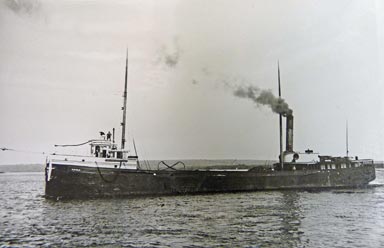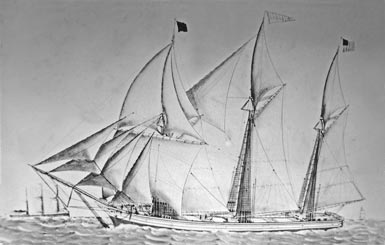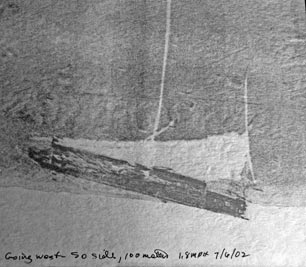DAVID TROTTER
 David Trotter has been involved in Great Lakes Shipwrecks......searching, diving, exploring and documenting new discoveries for 35+ years. The solving of "history's mysteries" has made significant contributions to the history of our Great Lakes and provided new exploration opportunities for sport and technical divers to enjoy.
David Trotter has been involved in Great Lakes Shipwrecks......searching, diving, exploring and documenting new discoveries for 35+ years. The solving of "history's mysteries" has made significant contributions to the history of our Great Lakes and provided new exploration opportunities for sport and technical divers to enjoy.
Dave's discoveries have been featured on the Discovery Channel, PBS, NBC and in the New York Times, Detroit Free Press, Canadian "DIVER" magazine, Lakeland Boating, "Wreck Diver" and "Immersed" dive magazines. His articles on Great Lakes Shipwrecks have been published in historical journals and national scuba diving publications.
He has searched and discovered shipwrecks in all of the Great Lakes (except Lake Ontario). In a unique odyssey, the years of dedicated effort to discover the largest schooner built in Canada (the 250' Minnedosa) resulted in surveying over 2,000 square miles of Lake Huron. This has been a one-of-a-kind adventure with 80-90 new sites, including airplanes, the steamer Daniel J. Morrell, and the steamer Goliath. The Goliath was designed by John Ericsson in 1846, fifteen years before he designed the ironclad Monitor of Civil War fame.
David believes the Great Lakes are "Our Treasure" to be enjoyed by all who love our "Inland Seas" and our Marine history. It is the Shipwreck Hunter discovering and the Diver exploring a shipwreck (in 20' or 300' of water) that has given us that unique experience of travelling back in time.
Our World Underwater (Chicago) honored David's contribution to diving and Great Lakes maritime history by presenting him with the very special 2010 Our World Underwater Achievement Award.
Dave's company, Undersea Research Associates, was founded to present the Great Lakes community with an electronically sophisticated means of underwater search and survey for archaeological and commercial purposes. He presents visual underwater time capsules of marine history. Utilizing state-of-the-art side scan sonar, with outstanding skilled operators, the organization offers high resolution bottom profiling at depths to 1,000 feet, underwater site survey and underwater photographic documentation.
Vanishing Points
Three new discoveries are explored: the Steamer E. B. Hale, the Barque Francis Berriman and Schooner "Y". Ship traffic was so congested on the Great Lakes in the 1800's that it may be compared to traffic on the highways of today, without the technology of today. Shipping disasters were commonplace on our "Inland Seas". Now, explorers can discover and attempt to solve the mysteries that occurred 100+ years ago. Is that really $150,000 laying on the floor of Lake Huron.....find out! |
E.B. Hale: The 218' Hale was built and launched June 11, 1874, having been designed for the iron ore, coal and grain trade. With 23 years of service and relatively few mishaps, the storm of 8/10/1897 was to claim her as she lost power and the cargo of steel billets shifted. The feed pipes leading to the pumps broke off close to the boiler, allowing all the steam and water out. The Hale was now at the mercy of Lake Huron and the crew abandoned ship, smashing one lifeboat, while managing to secure the 2nd to escape the sinking Hale. She plunged bow first into the cold depths of Lake Huron. It was reported that the storm was the most severe of the last 4 years. |
The 218' Steamer E. B. Hale underway prior to her loss. |
Sister ship to the Francis Berriman....the Schooner Lucerne underway. There are no known pics of the Berriman. |
Francis Berriman: The 183' Francis Berriman was built in 1872 and launched in Tonawanda, New York for grain and coal trade. While carrying 40,000 bushels of wheat loaded in Milwaukee, Wisconsin and destined for Buffalo, New York, she collided with the Steamer David Rust nearly head-on. The collision was brutal, with the 3 masted Berriman sinking in less than 15 minutes and taking two of her crew with her. |
This mystery ship, resting quietly and undisturbed for 125 years on the floor of Lake Huron, was found in July of 2002. The second mystery to the "mystery ship" is why did it take the explorers nine years to dive, explore and identify this well intact vessel from a bygone era? Share the excitement and learn the truth behind this vessel's exploration............why she was "The Lady In Waiting" for nine years! |
Original sidescan image when discovered in July of 2002. The mystery is: Why did the schooner remain a virgin, unexplored site for 9 years? |
 Speakers & Presentations
Speakers & Presentations

